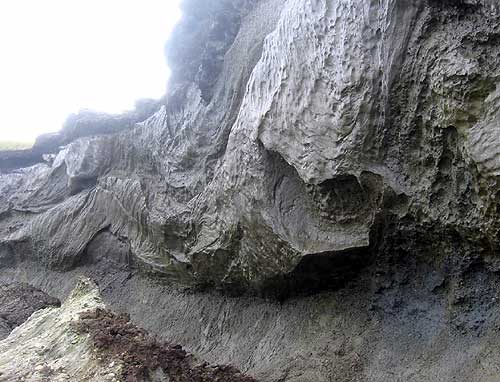 Storm exposes unknown glacier
on Alaska coast
Storm exposes unknown glacier
on Alaska coast
By NED ROZELL
December 18, 2008
Thursday
SAN FRANCISCO - Last August, a group of scientists flew to Kaktovik,
Alaska, hoping to catch a flight from the small village to study
permafrost features off the Jago River. But foggy weather pinned
them in the village, and their change in plans led them to a
glacier that no one knew about.
Torre Jorgenson of ABR Inc. was one of the scientists who wandered
the beach near Kaktovik to check out a massive chunk of shoreline
that fell into the sea during a storm on July 1, 2008. The storm
exposed about 1 kilometer of ice and soil.
 An ancient glacier
that scientists recently found exposed off Alaska's northern
coast near Kaktovik.
An ancient glacier
that scientists recently found exposed off Alaska's northern
coast near Kaktovik.
Photograph by Torre Jorgenson
"The Kaktovik residents had never seen such undercutting
of the bluff," Jorgenson said in San Francisco, as he discussed
the buried glacier at the fall meeting of the American Geophysical
Union, which draws dozens of scientists from Alaska and thousands
more from the rest of the world.
While Jorgenson and his colleagues from the University of Alaska
Fairbanks-Yuri Shur, Misha Kanevskiy, and Matt Dillon-walked
along the fresh ice bluffs 15 minutes from the village, they
saw masses of dirty brown ice with little rocks embedded in it.
It looked like glacier ice, but they knew that geologists claimed
that glaciers were never in that part of Alaska.
"At the end of the first day, we thought (the ice) was weird
stuff," Jorgenson said. "We thought it might be glacial
ice, but then said, 'No, it can't be.'"
But the more the researchers
looked at the ice, the more they thought of glaciers. Kanevskiy
had studied ice formed at the base of Matanuska and Muldrow glaciers,
and the ice in the bank at Kaktovik was the same type, with plenty
of the sand and silt and pebbles that glaciers usually carry
along.
"By the second day, we were convinced (it was glacier ice),"
Jorgenson said.
The crew cancelled their plans to fly to the Jago River and concentrated
on the discovery of Alaska's northernmost glacial ice.
Jorgenson said that scientists have since the early 1900s wondered
about polished pebbles they'd found on Alaska's northern coast,
and many other clues that suggested a great icefield once existed
where Alaska touches the Arctic Ocean. While working on Alaska's
North Slope since the late 1970s, Jorgenson has seen and heard
about many clues that suggested the area might have been under
ice-including gouge-marks on the ocean floor off the coast and
sand deposits in unusual areas. But it wasn't until last August
that he had proof.
"Once we found basal ice (the type formed by glaciers),
we found our smoking gun," Jorgenson said.
He envisions the northern glacier as a giant ice sheet that extended
from Arctic Canada to west of the Colville River, burying most
of Alaska's Arctic Ocean coast. He said the absence of any signs
of early humans along the coast northeast of the famous Mesa
Site is probably because that area of the North Slope was under
ice.
The discovery was yet another example of scientific serendipity,
in this case when a plane couldn't fly because of bad weather,
the researchers said.
"This trip was originally designed to be pretty different,"
Dillon said. "(The glacier ice) was definitely a freak encounter."
"It was a fortuitous combination of a big storm, getting
weathered in, and having some of your colleagues there who were
studying the same thing in mountain glaciers," Jorgenson
said.
The storm that exposed that ancient ice for the first time in
thousands of years might foreshadow a period of extreme loss
of land along Alaska's northern coast, Jorgenson said.
"It wasn't that big a storm, but the (sea) ice was completely
out to Russia," he said. "It's the harbinger of a new
regime, I guess."
This column is provided
as a public service by the Geophysical Institute,
University of Alaska Fairbanks, in cooperation with the UAF research
community.
Ned Rozell [nrozell@gi.alaska.edu]
is a science writer at the institute.
E-mail your news &
photos to editor@sitnews.us
Publish A Letter in SitNews Read Letters/Opinions
Contact the Editor
SitNews
©2008
Stories In The News
Ketchikan, Alaska
|

